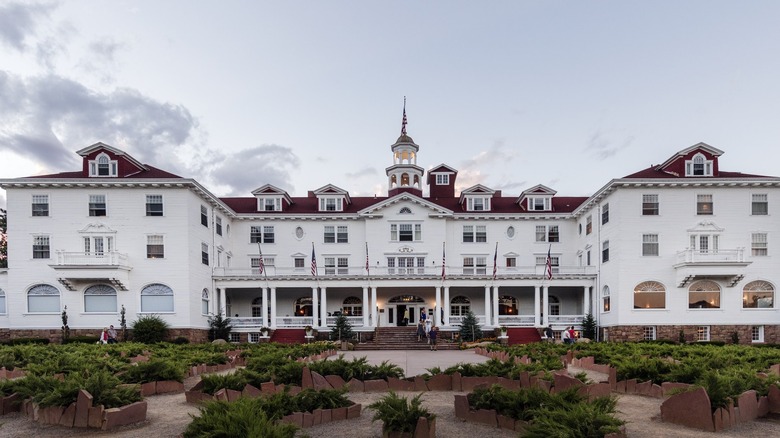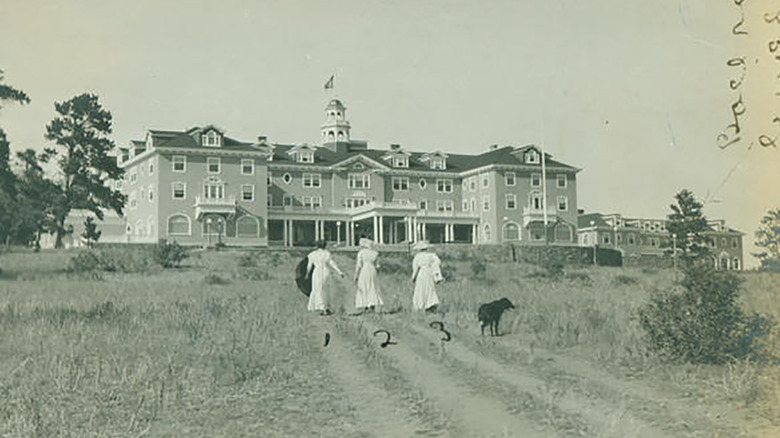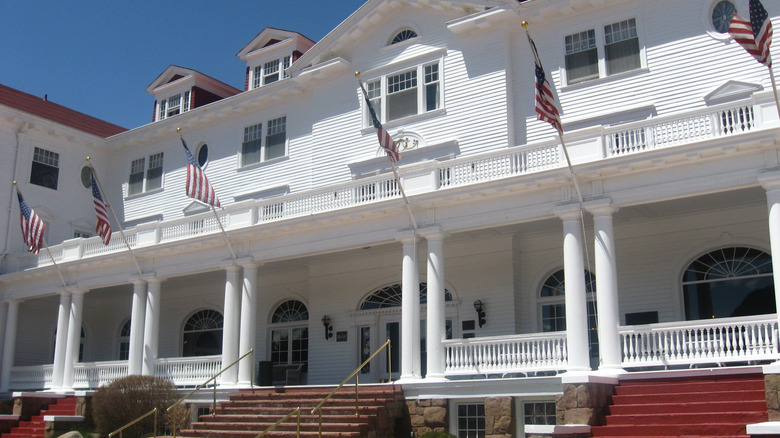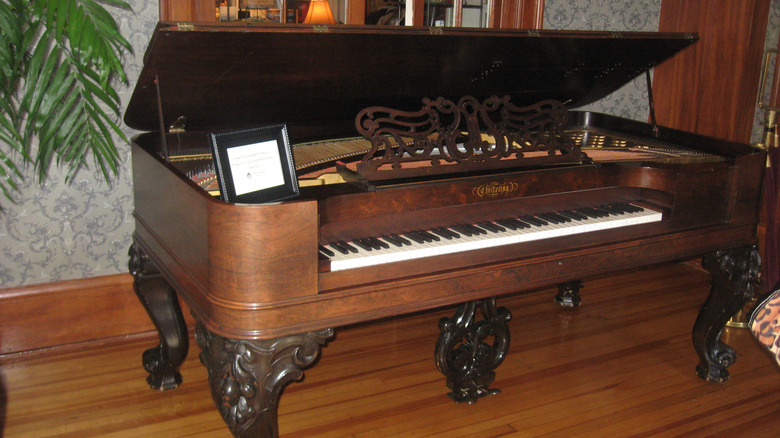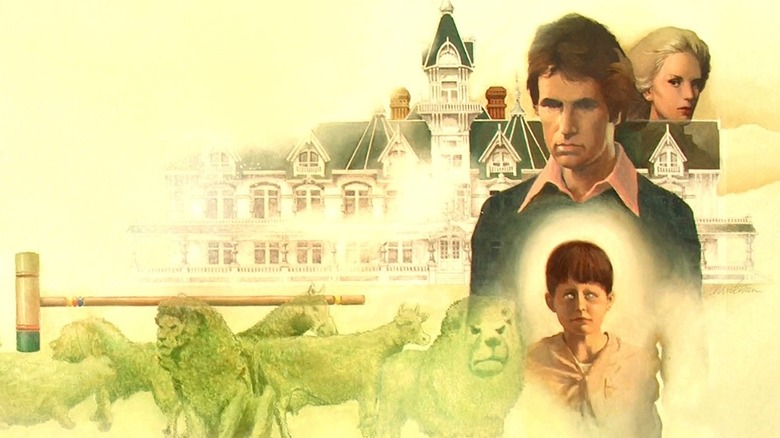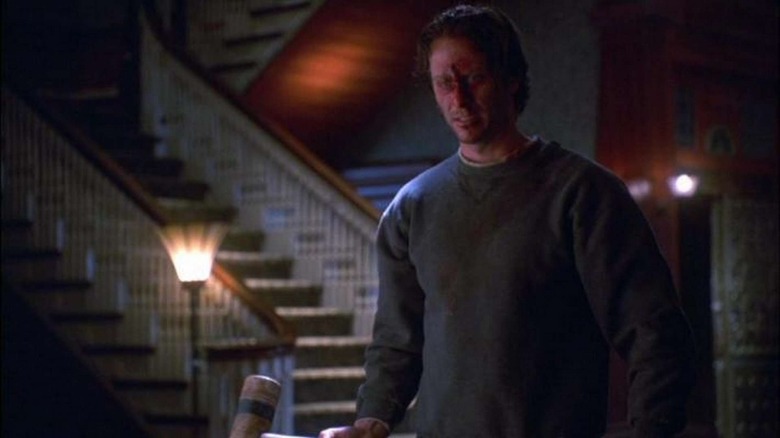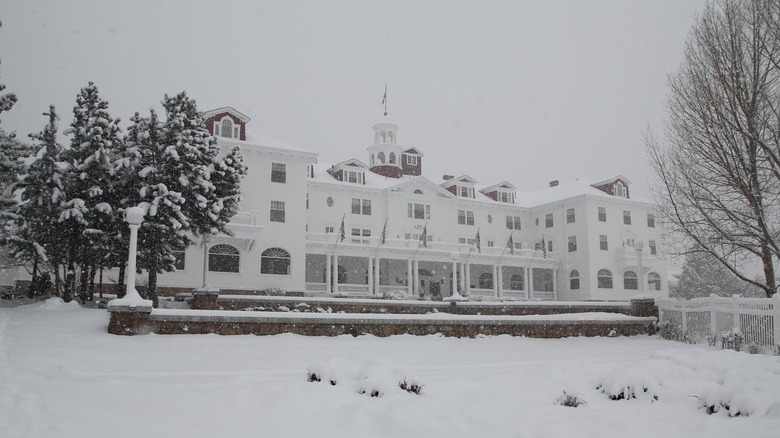The Haunted History Behind The Shining's Stanley Hotel
While fans of Stanley Kubrick's adaptation of Stephen King's "The Shining" might have a love for the fictional Overlook Hotel, King was inspired by a real, historically haunted hotel: The Stanley Hotel in Estes Park, Colorado. The Stanley has been embedded in my psyche since childhood, so I can understand King's reaction to the place. It's an imposing, beautiful building that somehow emanates a feeling of wrongness, a "bad vibe" that's almost impossible to shake even if you're a true-blue skeptic. King was so shaken by his stay at the Stanley while he was in Colorado that it inspired him to write "The Shining," which went on to be one of his most famous works.
The Stanley Hotel sits on a huge foothill nestled in the Rocky Mountains, in the tourist town of Estes Park. As a child growing up in a nearby Denver suburb, Estes Park was the one vacation my family could afford each year — a place where we could race go-karts and go hiking in the beautiful Rocky Mountain National Park. On our way to whichever tiny riverside cabin we had rented, we would pass the Stanley up on the hill, leering down at us from on high. When my parents explained to me that it was the very hotel that had inspired "The Shining," I felt justified in being creeped out. Years later, I would return to the Stanley, take the ghost tour, and spend the night — and its haunted halls have lingered in my memory ever since.
What is it about the Stanley Hotel that leaves its guests so unnerved? Is it just the stories of hauntings and King's association that make people see and hear things that aren't actually there? Or is it truly as haunted as its fictional counterpart?
The history behind this haunted hotel
According to the Stanley Hotel's website, when inventor Freelan Oscar Stanley arrived in the valley of Estes Park in 1903, he discovered the mountain air helped ease his tuberculosis symptoms. He planned to return to the town every summer until the day he died — but he and his wife, Flora Stanley, were accustomed to a different lifestyle than what Estes Park could offer. They built the Stanley Hotel, which officially opened in 1909, as a home away from home where they could host friends and other guests. The hotel was designed to be top-of-the-line, with electric lights, telephones, bathrooms attached to each room, and a staff of uniformed servants. Stanley Hotel even boasted a fleet of steam-powered automobiles, one of which has been on display at the hotel for decades. By 1917, the tiny hamlet of Estes Park was an official municipality that owed its development to Stanley and his hotel.
Throughout the hotel's history, there have been reports of ghostly apparitions. When I visited with my family about a decade ago, guests could sign up for a ghost tour that highlighted all of the most haunted rooms in the hotel. Stanley himself is said to wander the halls, most often in the hotel bar. Sightings of his wife Flora have also been reported, usually of her playing her piano in the ballroom. Employees and guests both have reported hearing piano music coming from the room and seeing the keys moving. I didn't hear the music or see the keys move, but the ballroom does feel colder the closer you get to the beautiful grand piano.
Room 407 is supposedly haunted by Lord Dunraven, the man who owned the land prior to Stanley. Some guests have reported seeing his face in the window even when the room isn't booked. Room 418 is haunted by children, whose laughter can be heard in the hallways by guests and cleaning crew inhabiting the room. The ghost of a small boy is said to appear outside of room 217, where author Stephen King stayed, and he reportedly saw the child, who was calling out for his nanny. Brave guests on the hotel tour can stand in the closet in one of the haunted rooms, where voices are said to be the loudest. I volunteered, and while I didn't hear anything besides my own heartbeat in my throat, I can definitely appreciate the kind of fear King must have felt while visiting back in 1974.
The 1911 explosion
There have been several unexplained or spooky accidents over the course of the hotel's history, which only adds to the legend of the building be cursed. On June 25, 1911, Elizabeth Wilson, the head chambermaid at the two-year-old hotel, went into room 217 with a lit candle, only to tragically discover there was a leak in the hotel's gas lanterns. The candle ignited the gas and there was a major explosion, destroying about one-tenth of the hotel and putting Wilson into a coma.
Wilson miraculously survived and continued working at the hotel until 1950. According to some guests who have stayed in room 217, the maid is still working there in the afterlife. Guests have said that they woke up with their room straightened up and their suitcases neatly organized. Now that's a friendly ghost.
A spooky pet cemetery
Believe it or not, not all the ghosts in the Stanley are purported to be the human kind. There is a pet cemetery on the property where the owners of the hotel buried their pets over the years, and guests have reported seeing the ghosts of some of the animals buried there wandering the property. Among them are a golden retriever named Cassie and a white cat named Comanche, and they have been spotted all throughout the grounds, including in the hallways and guest rooms.
Funnily enough, the cemetery and ghost stories predate King's novel "Pet Sematary," which features animals coming back to life after being buried in a cursed cemetery. Cassie and Comanche didn't come back from the dead, but according to some guests, they're still hanging around in some form. It's probably a lot less scary stumbling across a spirit dog or cat than a person, especially given the hotel's history and connection to "The Shining." Maybe guests should bring some dog treats, just in case.
The Shining connection
In the 1970s, the Stanley Hotel was starting to fall into a state of disrepair, but the arrival of a rising author would change everything. In late September of 1974, King and his wife Tabitha spent a night at the Stanley. He recounts the experience on his website:
"We were the only guests as it turned out; the following day they were going to close the place down for the winter. Wandering through its corridors, I thought that it seemed the perfect—maybe the archetypical—setting for a ghost story. That night I dreamed of my three-year-old son running through the corridors, looking back over his shoulder, eyes wide, screaming. He was being chased by a fire-hose. I woke up with a tremendous jerk, sweating all over, within an inch of falling out of bed. I got up, lit a cigarette, sat in the chair looking out the window at the Rockies, and by the time the cigarette was done, I had the bones of the book firmly set in my mind."
King stayed in the book's infamous Room 217, turned into Room 237 for Kubrick's adaptation. Visitors to the Stanley can purchase room number plates from Room 217 to hang in their own homes, if they dare.
King published "The Shining" in 1977, and it was a huge hit, following in the footsteps of "Carrie" and "Christine." The book would be adapted into a feature film by director Stanley Kubrick in 1980, though King is not a fan of the many changes that Kubrick made. The author set out to help make a more accurate version of his story for a television miniseries on ABC in 1997.
Giving the Shining miniseries some authenticity
The 1997 "Stephen King's The Shining" miniseries is notorious for its cheesy made-for-TV moments, but it is much more accurate to the author's original story. In addition to the production team working with King in order to get his approval this time around, the miniseries was also filmed at the Stanley Hotel. (Kubrick's Overlook was created almost entirely on a soundstage in London, with exterior shots done at the Timberline Lodge on Mount Hood in Oregon.) The real hotel that inspired King's work is a perfect backdrop for the terrifying tale, and the Stanley's eerie vibe practically oozes out of the screen.
The filming of the miniseries was a big event in Estes Park, and I happened to be there for part of it at a Girl Scout event nearby. I'll never forget seeing all of the vans and trucks carrying movie-making equipment going down the tiny Estes Park main street toward the hotel. The miniseries is flawed, but there's still plenty to love about it, including preserving the Stanley Hotel for all time.
Is it really haunted?
While I didn't experience anything too ghostly during my own stay at the Stanley, it was impossible to shake the feeling I was being watched at all times. There are spots of cold that could be the result of the building's ancient bones, or could be spirits making their presence known. It's hard not to be a tiny bit uncomfortable while staying in the Stanley, especially when there's a channel on the TV in every room that plays Kubrick's "The Shining" on a 24-hour loop. There are also plenty of reminders of the building's creepy connections, including the word "REDRUM" scrawled on an attic door. The hotel added its own miniature version of the movie's hedge maze in 2015, so fans of both King and Kubrick can really get the most out of visiting this historic hotel.
One day I hope to visit it again and stay in Room 217 — and maybe then I'll get some truly ghostly stories to share with everyone.
